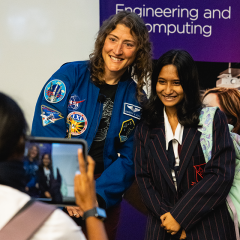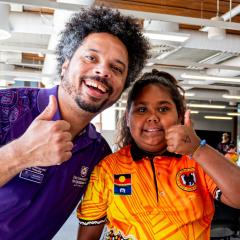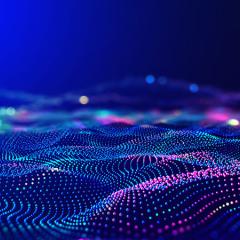
Last March, we held an event with NASA astronaut Christina Koch to learn more about her career, life in space, and about her future journey to the Moon aboard the Artemis II mission.
We asked High School and Engineering students, industry partners, and academics to send questions and compiled into themes to be discussed on stage. Professor Tamara Davis hosted the Q&A, and here are the main lessons from this exclusive event:
“You want me to stand up again?”
The first question of the interview was about readapting to gravity: “what makes it hard to walk after a mission in space?”
For Christina, it is a combination of factors, starting from how astronauts use their bodies in space. “Because we work out a lot – and it's mandated – typically the big muscle groups that we have, they're all working fine. You might actually even come back from space stronger than you were. But all of the little stabilization muscles are really hard to work”, Christina says.
Another major factor lies on to how the brain responds to zero gravity environments: “So when you first get to space, your inner ear is just sending basically gobbledygook to your brain, and your brain adapts and stops listening to that organ. And so when you first get back, you do not have that signal like the rest of us do based on of gravity vector to tell you how you're oriented. And so the funniest thing you could you visually, but that's a really lagging indicator. So I would be for example, standing up, everything would be fine. And I would close my eyes and just to pray over I mean that, you know, hopefully people would be there to help me.”
Lastly, the cardiovascular system relearns how to carry our body weight: “Even though we work out a lot, your body's really good at adapting and it adapts to microgravity and your heart doesn't work as hard, and giving all that back can take months. I felt like I had bowling balls hanging from my arms because it was just like even lifting my own body weight was a real chore.”
Being bad at things
For students, especially high achievers, learning to thrive out of the comfort zone can be a real struggle. For a highly trained professional like Christina, it wasn’t different. On her path to become an astronaut, she had to transition from being in a stable career for fifteen years into learning five new roles in only two years, and with it came the importance of embracing the learning process: “I knew how to do my stuff pretty well, and then I was asked to do a whole bunch of new stuff and that could feel really bad. But when you think about it, that's the only way we're going to become better and be able to contribute more to the world. So just be comfortable being uncomfortable.”
How do I become an astronaut?

Among the students in the audience, the most asked questions were about the qualifications needed to become an astronaut. There are many pathways and skills that can take you there, as it happened with Christina. She has two Bachelor of Science degrees in Electrical Engineering and Physics and a Master of Science in Electrical Engineering, but what really caught NASA’s attention was her experience working at the South Pole, rock climbing and other challenges she faced: “We talked about all these things that I love to do, but they were things I did on the side. So, it turned out to be more important that I developed as a whole person. And then I put myself in uncomfortable places. And then they knew that I could continue to do that.”
Is zero gravity as fun as it looks?

The answer is always yes! For Christina, there are so many fun things astronauts would do, from human bowling to floating food. “That was pretty much an everyday thing. It's just always fun, from the first moment you get there because everything flips, even things you don’t expect.”
Spacewalks are amazing – but can be scary, too
Christina is a pioneer in spacewalking – In 2019, she and Jessica Meir were the first women to participate in an all-woman spacewalk, and she also broke the world record for the longest single spaceflight for a woman.

But life in space is not all fun and games – as she recalls her scariest moment aboard the International Space Station (ISS): “We were in the airlock doing some switches, and my buddy had just opened the hatch to go out and I flipped my feet up. And I looked down here at a place that normally is just the walls and the hatch, and it was this big gaping hole of blackness! I knew I had to get out, and my heart rate shot through the roof instantaneously!”
Every failure brings you to this moment
At NASA, there is a saying that astronauts are the calmest people on launch day. Christina remembers thinking that this would be impossible, until her debut finally happened. And she explains what happened: “There is something about turning all fear, nervousness, anxiety, and channelling it into focus, into this idea that you are finally doing what you have trained for, you are finally able to give back. You are finally taking every experience you have had in your whole life every failure, every success, every regret, every time you fail. It is all coming into this moment and you are ready to do the job you came here for, that you were made to do.”
What can we learn from science in space?

Between “who we are?” and “is there anybody out there?”, there are a million other things we can learn from space. And Christina spent countless hours studying the fundamental things about physics and the properties of liquids, gases and solids with varied levels of gravity. But science in space also brings tangible benefits for our health, such as the pharmaceutical research on drugs for treating cancer, Parkinson’s and Alzheimer’s diseases: “There are ways of having complex molecules like proteins build crystals that cannot happen on Earth. They would otherwise not be able to construct themselves under their own way.”
The future of space travel
When asked by Professor Davis about her insights on the future of space travel, Christina pondered about how to navigate around the Moon: “There's no GPS constellation at the Moon. We go there, we have to figure out where we are at first and foremost. So, we are inventing the way to do that around the Moon.”
Another deep question comes from the distance between the Earth and other planets. When astronauts go to the ISS or to the Moon, they have a gorgeous view of the Earth. On Mars, Earth will look like a twinkling star in a wild environment’s sky. And for Christina, this will be the moment when we really learn who we are: “How do we maintain our humanity when we go so far away from spaceship Earth?”
A world without boundaries

From space, Christina hardly sees any lines or boundaries on Earth, an image that was more profound than she could have ever imagined. However, her biggest takeaway from working with scientists from all over the world is the diversity of people: In closing, Professor Davis and Christina acknowledged the collaborative effort of the nations involved in constructing the ISS, which is in orbit for 26 years: “It's awesome to know that no one country could have done what we did alone, and we could have chosen to not have a space station, or we could have chosen to work together and have one. And I'm really happy we chose what we did.”



